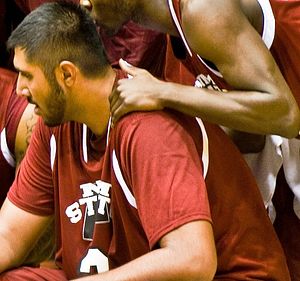When Sim Bhullar, a 7-foot-5 inch rookie center checked in for the Sacramento Kings with just 16 sixteen seconds left against the Minnesota Timberwolves on Tuesday, the crowd at Sleep Train Pavilion leapt to their feet. That’s not how fans typically respond when a rarely-used big man suits up. But when Bhullar took the floor, the undrafted New Mexico State product made history, becoming the NBA’s first player of Indian descent.
Bhullar, a native of Toronto whose parents hail from Punjab, India, may not last in the league. As he rose through the ranks alongside Canadian prep cohorts Andrew Wiggins, Anthony Bennett, and Kings teammate Nik Staukas, scouts proved less than bullish on Bhullar’s professional prospects. “Sim Bhullar has definitely made some progress, but still has a long ways to go with his conditioning,” the website Draft Express noted in the summer of 2011. At 355 pounds, Bhullar looks flabby compared to All-Star DeMarcus Cousins and gangly veteran Reggie Evans, who soak up most of the playing time in the Kings frontcourt.
Bhullar is used to being the underdog, however. While Wiggins, Bennett, and Stauskas won athletic scholarships to start at top-flight Division I schools, Bhullar had to enroll as a student at second-tier New Mexico State to play ball. His contract with the Kings is only good for ten days and if that deal isn’t extended, Bhullar will likely be sent to play in the Development League, the NBA’s farm system, after the Kings play the Oklahoma City Thunder on Friday night. The so-called “D-League” doesn’t have a wonderful track record of developing NBA-ready players: last year, only 37 players were called up, most of them on short-term deals.
Though Bhullar chances of making it as a pro are slim, his two minutes of NBA action are significant back in India. “While he tries to honor the past and inspire the future, Bhullar’s most important mission at first is to make the most of the present moment,” Karan Madhok, a writer with NBA India, the league’s offshore affiliate, wrote of Bhullar’s debut. Bhullar’s task, Madhok continued, is “to make the most for himself as a lover of basketball, and for the diaspora of basketball-loving Indians worldwide who’ll proudly celebrate every moment with him.” When Bhullar visited his ancestral homeland in 2011, some of those basketball lovers came out of the woodwork, mobbing him at the Golden Temple in Amritsar, a Sikh holy site.
The NBA has struggled to make inroads in the world’s second-largest country, where it televises five games each week. Through NBA Cares, the league’s global outreach initiative, it sponsors health and fitness trainings throughout India. In 2013, there was speculation that then-commissioner David Stern would sign a deal with IMG Reliance, an entertainment agency helping to develop the sport in India, to start a league. But Stern was cagey about that endeavor. “I think that is a couple of years away, at least,” he noted.
Compare that to the wild success of the NBA in China. Stern’s replacement, Adam Silver, has continued the NBA’s high-profile courtship of Chinese fans. Around 100 million people regularly watch the association in China, and the league’s offshore affiliate routinely grows by more than 10 percent clip per year, bolstered by a $500 million deal with Tencent to carry games. The Golden State Warriors and Houston Rockets even donned commemorative jerseys in late February to celebrate Chinese New Year.
The league’s growth in China only took off after Yao Ming starred for the Rockets, making eight NBA All-Star teams. More recently, Harvard product Jeremy Lin, whose family hails from Taiwan, became an overnight sensation while leading Mike D’Antoni’s up-tempo offense with the New York Knicks. India needs a superstar of that caliber to elevate the game in the subcontinent, where cricket reigns supreme. Unless Sim Bhullar can conjure some magic in the waning days of his contract, that search will continue.
































